 Homemade chicken noodle soup made in the crock pot for a set-it-and-forget-it easy dinner. You can evan prep all the ingredients ahead of time and store them in the freezer to pull out on a day where you forgot to plan dinner. Just make sure you thaw the ingredients before adding it to the slow cooker to prevent it from staying at an unsafe temperature for too long. 8 ounces whole-wheat egg noodles or other whole-wheat noodles 3 pounds bone-in chicken breast, skin removed 2 cups chopped onion 1 cup chopped carrot 1 cup chopped celery 2 sprigs thyme 8 cups low-sodium chicken broth 2 teaspoons kosher salt 2 cups frozen peas ¼ cup chopped fresh dill, plus more for garnish 2 tablespoons lemon juice
1 Comment
The adolescent dancer faces unique challenges due to physical and emotional changes that occur during pubertal development. Rapid growth periods can lead to reduced strength, impaired balance, and decreased flexibility, which can alter technical ability and increase the risk of injury.
GROWTH CHANGES Growth spurts in dancers usually occur between the ages 11-15 in girls and 13-17 in boys, and can last up to two years (IADMS 2000). As height increases, weight gain also occurs. A girl’s menstrual cycle begins during these growth phases and is essential for formation of bone. The pressure to stay thin during periods of weight gain in addition to being unaware of/ignoring nutritional needs results in an energy deficit and increases the likelihood of irregular periods (Delegate 2018). Bones grow at a faster rate than muscles and tendons, and limbs grow at a faster rate than the trunk. This affects strength, flexibility, and balance control in dancers. These changes can make movement feel awkward and may affect your ability to perform at the level that you are used to. Don’t be discouraged, these changes are temporary! INJURY RISKS The injury rate increases by 35% as dancers reach ages 14-16. Body regions most commonly affected are the foot/ankle, lumbar spine, hips, and knees (Steinberg 2012, Delegate 2018). Common injury types in adolescents:
REDUCING INJURY RISK DURING GROWTH CHANGES:
References: 1)Education Committee (Kathryn Daniels, Chair). International Association for Dance Medicine & Science. November 2000 https://www.iadms.org/page/1 2) Delegete, A. Health Considerations for the Adolescent Dancer. A webinar through the Harkness Center for Dance Injuries. Accessed September 23, 2018. 3) Steinberg, N., Siev-Ner, I., Peleg, S., Dar, G., Masharawi, Y., Zeev, A., & Hershkovitz, I. (2012). Extrinsic and intrinsic risk factors associated with injuries in young dancers aged 8–16 years. Journal of sports sciences, 30(5), 485-495. 4) Steinberg, N., Siev-Ner, I., Peleg, S., Dar, G., Masharawi, Y., Zeev, A., & Hershkovitz, I. (2013). Injuries in female dancers aged 8 to 16 years. Journal of athletic training, 48(1), 118-123. 11/4/2018 3 Comments Eating for Immunity The immune system provides protection from seasonal illness such as the common cold as well as other health problems including arthritis, allergies, abnormal cell development and cancers. Dancers are exposed to physical stress from training, which increases susceptibility to illness. Additionally, working in close proximity with other dancers increases exposure to infection. Nutrition plays an important role in maintaining immune function to protect against infection. Learn how to boost your immunity by including these nutrients in your eating plan. Proteins form many immune cells and transporters. Try to consume a variety of protein foods including seafood, lean meat, poultry, eggs, beans and peas, soy products and unsalted nuts and seeds. Vitamin A helps regulate immune function and protects from infections by maintaining healthy tissues in skin, mouth, stomach, intestines and respiratory system. Vitamin A is found in foods such as sweet potatoes, carrots, kale, spinach, red bell peppers, apricots, eggs or foods labeled "vitamin A fortified," such as cereal or dairy foods. Vitamin E works as an antioxidant to neutralize free radicals. Include vitamin E in your diet with fortified cereals, sunflower seeds, almonds, vegetable oils (such as sunflower or safflower oil), hazelnuts and peanut butter. Vitamin C protects stimulates the formation of antibodies, which are necessary to fight infection. Citrus fruits such as oranges, grapefruit and tangerines, red bell pepper, papaya, strawberries, and tomato juice are good sources of vitamin C. Zinc is critical for wound healing and aids the immune system. This mineral can be found in lean meat, poultry, seafood, milk, whole grain products, beans, seeds and nuts. Other nutrients, including vitamin B6, folate, selenium, iron, as well as prebiotics and probiotics, may also influence immune response. References: Academy of Nutrition and Dietetics (2017). Protect Your Health with Immune-Boosting Nutrition. Retrieved at eatright.org. |
CategoriesAll Cross Training Injury Prevention Nutrition Recipes Wellness Archives
October 2021
|
 RSS Feed
RSS Feed